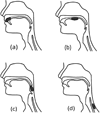Decoding human swallowing via electroencephalography: a state-of-the-art review
- PMID: 26372528
- PMCID: PMC4596245
- DOI: 10.1088/1741-2560/12/5/051001
Decoding human swallowing via electroencephalography: a state-of-the-art review
Abstract
Swallowing and swallowing disorders have garnered continuing interest over the past several decades. Electroencephalography (EEG) is an inexpensive and non-invasive procedure with very high temporal resolution which enables analysis of short and fast swallowing events, as well as an analysis of the organizational and behavioral aspects of cortical motor preparation, swallowing execution and swallowing regulation. EEG is a powerful technique which can be used alone or in combination with other techniques for monitoring swallowing, detection of swallowing motor imagery for diagnostic or biofeedback purposes, or to modulate and measure the effects of swallowing rehabilitation. This paper provides a review of the existing literature which has deployed EEG in the investigation of oropharyngeal swallowing, smell, taste and texture related to swallowing, cortical pre-motor activation in swallowing, and swallowing motor imagery detection. Furthermore, this paper provides a brief review of the different modalities of brain imaging techniques used to study swallowing brain activities, as well as the EEG components of interest for studies on swallowing and on swallowing motor imagery. Lastly, this paper provides directions for future swallowing investigations using EEG.
Figures




References
-
- Abe S, Wantanabe Y, Shintani M, Tazaki M, Takahashi M, Yamane G, et al. Magnetoencephalographic study of the starting point of voluntary swallowing. Cranio. 2003;21(1):46–49. - PubMed
-
- Ang KK, Chua KSG, Phua KS, Wang C, Chin ZY, Kuah CWK, Low W, Guan C. A randomized controlled trial of EEG-based motor imagery brain-computer interface robotic rehabilitation for stroke. Clinical EEG and Neuroscience. 2014a:1–11. - PubMed
-
- Ang KK, Guan C, Phua KS, Wang C, Zhou L, Tang KY, Joseph GJE, Kuah CWK, Chua KSG. Brain-computer interface-based robotic end effector system for wrist and hand rehabilitation: results of a three-armed randomized controlled trial for chronic stroke. Frontiers in Neuroengineering. 2014b;7(30) - PMC - PubMed
-
- Araki M, Yamamoto K. Multivariable multirate sampled-data systems: state-space description, transfer characteristics, and nyquist criterion. IEEE Transactions on Automatic Control. 1986;31(2):145–154.
Publication types
MeSH terms
Grants and funding
LinkOut - more resources
Full Text Sources
Other Literature Sources
Medical
Miscellaneous
